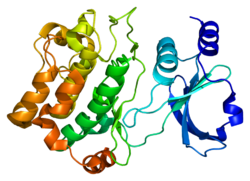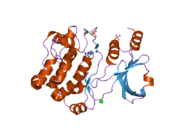| PAK6 | |||||||||||||||||||||||||||||||||||||||||||||||||||
|---|---|---|---|---|---|---|---|---|---|---|---|---|---|---|---|---|---|---|---|---|---|---|---|---|---|---|---|---|---|---|---|---|---|---|---|---|---|---|---|---|---|---|---|---|---|---|---|---|---|---|---|
 | |||||||||||||||||||||||||||||||||||||||||||||||||||
| |||||||||||||||||||||||||||||||||||||||||||||||||||
| Identifiers | |||||||||||||||||||||||||||||||||||||||||||||||||||
| Aliases | PAK6, PAK5, p21 (RAC1) activated kinase 6 | ||||||||||||||||||||||||||||||||||||||||||||||||||
| External IDs | OMIM: 608110; MGI: 2679420; HomoloGene: 23200; GeneCards: PAK6; OMA:PAK6 - orthologs | ||||||||||||||||||||||||||||||||||||||||||||||||||
| |||||||||||||||||||||||||||||||||||||||||||||||||||
| |||||||||||||||||||||||||||||||||||||||||||||||||||
| |||||||||||||||||||||||||||||||||||||||||||||||||||
| |||||||||||||||||||||||||||||||||||||||||||||||||||
| Wikidata | |||||||||||||||||||||||||||||||||||||||||||||||||||
| |||||||||||||||||||||||||||||||||||||||||||||||||||
Serine/threonine-protein kinase PAK 6 is an enzyme that in humans is encoded by the PAK6 gene.
PAK6 belongs to the Group II PAK family members. Like other family members, PAK6 is also evolutionary conserved across species.
Discovery
The PAK6 was originally cloned as an androgen receptor interacting kinase which can be stimulated by androgen receptor but not Rac or Cdc42, like other family members.
Gene and spliced variants
The human PAK6 gene consists of 16 exons of which 8 exons are used for 5’-UTR splicing to generating 17 transcripts by alternative splicing, and the gene is about 38-kb long. Among PAK6 transcripts, 14 are protein coding RNAs to code four proteins of 681 and 636 amino acids while remaining PAK6 transcripts are non-coding RNAs. There are five transcripts in murine PAK6 gene, of which two transcripts are protein coding and other two non-coding RNAs(Gene from review).
Protein domains
Following the general structural organization of the group II PAKs, PAK6 also contains a kinase, and a GTPase interacting domain.
Function
This gene encodes a protein that shares a high degree of sequence similarity with p21-activated kinase (PAK) family members. The proteins of this family are Rac/Cdc42-associated Ste20-like Ser/Thr protein kinases, characterized by a highly conserved amino-terminal Cdc42/Rac interactive binding (CRIB) domain and a carboxyl-terminal kinase domain. PAK kinases are implicated in the regulation of a number of cellular processes, including cytoskeleton rearrangement, apoptosis and the MAP kinase signaling pathway. The protein encoded by this gene was found to interact with androgen receptor (AR), which is a steroid hormone-dependent transcription factor that is important for male sexual differentiation and development. The p21-activated protein kinase 6 gene was found to be highly expressed in testis and prostate tissues and the encoded protein was shown to cotranslocate into the nucleus with AR in response to androgen.
Genetic deletion of PAK6 alone in mice leads to increased body mass. However, PAK6 deletion along with PAK5 impairs the ability of animals to learn and move. PAK6 expression is increased in a rat model of spinal cord injury. PAK6 is also considered a candidate gene for epileptic encephalopathy, and interacts with Parkinson associated gene product leucine-rich repeat kinase 2. PAK6 expression has been found to be overexpressed in prostate cancer, hepatocellular carcinoma, and colon cancer. PAK6 levels have been correlated well with therapeutic resistance to 5-flurouracil, docetaxel, and radiation.
Regulators and interactors
PAK6 kinase activity is positively regulated by androgen receptor, p38MAPK, 5-fluorouracil and atypical Rho family GTPase Chp/RhoV. PAK6 expression is negatively regulated by miR-328, miR-429 and miR-23a. PAK6 interacts with junctional protein IQGAP1, E3 ligase Mdm2, and leucine-rich repeat kinase 2 (LRRK2).
Interactions
PAK6 has been shown to interact with Androgen receptor.
Notes
| The 2016 version of this article was updated by an external expert under a dual publication model. The corresponding academic peer reviewed article was published in Gene and can be cited as: Rakesh Kumar, Rahul Sanawar, Xiaodong Li, Feng Li (19 December 2016). "Structure, biochemistry, and biology of PAK kinases". Gene. Gene Wiki Review Series. 605: 20–31. doi:10.1016/J.GENE.2016.12.014. ISSN 0378-1119. PMC 5250584. PMID 28007610. Wikidata Q38779105. |
References
- ^ GRCh38: Ensembl release 89: ENSG00000137843 – Ensembl, May 2017
- ^ GRCm38: Ensembl release 89: ENSMUSG00000074923 – Ensembl, May 2017
- "Human PubMed Reference:". National Center for Biotechnology Information, U.S. National Library of Medicine.
- "Mouse PubMed Reference:". National Center for Biotechnology Information, U.S. National Library of Medicine.
- ^ Yang F, Li X, Sharma M, Zarnegar M, Lim B, Sun Z (May 2001). "Androgen receptor specifically interacts with a novel p21-activated kinase, PAK6". The Journal of Biological Chemistry. 276 (18): 15345–53. doi:10.1074/jbc.M010311200. PMID 11278661.
- ^ "Entrez Gene: PAK6 p21(CDKN1A)-activated kinase 6".
- ^ Lee SR, Ramos SM, Ko A, Masiello D, Swanson KD, Lu ML, Balk SP (January 2002). "AR and ER interaction with a p21-activated kinase (PAK6)". Molecular Endocrinology. 16 (1): 85–99. doi:10.1210/mend.16.1.0753. PMID 11773441.
- Kumar A, Molli PR, Pakala SB, Bui Nguyen TM, Rayala SK, Kumar R (July 2009). "PAK thread from amoeba to mammals". Journal of Cellular Biochemistry. 107 (4): 579–85. doi:10.1002/jcb.22159. PMC 2718766. PMID 19350548.
- Kumar R, Li DQ (2016). PAKs in Human Cancer Progression: From Inception to Cancer Therapeutic to Future Oncobiology. Vol. 130. pp. 137–209. doi:10.1016/bs.acr.2016.01.002. ISBN 9780128047897. PMID 27037753.
{{cite book}}:|journal=ignored (help) - Shao YG, Ning K, Li F (January 2016). "Group II p21-activated kinases as therapeutic targets in gastrointestinal cancer". World Journal of Gastroenterology. 22 (3): 1224–35. doi:10.3748/wjg.v22.i3.1224. PMC 4716033. PMID 26811660.
- ^ Furnari MA, Jobes ML, Nekrasova T, Minden A, Wagner GC (2013). "Functional deficits in PAK5, PAK6 and PAK5/PAK6 knockout mice". PLOS ONE. 8 (4): e61321. Bibcode:2013PLoSO...861321F. doi:10.1371/journal.pone.0061321. PMC 3620390. PMID 23593460.
- Nekrasova T, Jobes ML, Ting JH, Wagner GC, Minden A (October 2008). "Targeted disruption of the Pak5 and Pak6 genes in mice leads to deficits in learning and locomotion". Developmental Biology. 322 (1): 95–108. doi:10.1016/j.ydbio.2008.07.006. PMID 18675265.
- Zhao W, Yang J, Shi W, Wu X, Shao B, Wu Q, Chen J, Ni L (June 2011). "Upregulation of p21-activated Kinase 6 in rat brain cortex after traumatic brain injury". Journal of Molecular Histology. 42 (3): 195–203. doi:10.1007/s10735-011-9324-8. PMID 21541790. S2CID 23042073.
- Oliver KL, Lukic V, Freytag S, Scheffer IE, Berkovic SF, Bahlo M (February 2016). "In silico prioritization based on coexpression can aid epileptic encephalopathy gene discovery". Neurology. Genetics. 2 (1): e51. doi:10.1212/NXG.0000000000000051. PMC 4817907. PMID 27066588.
- ^ Civiero L, Cirnaru MD, Beilina A, Rodella U, Russo I, Belluzzi E, Lobbestael E, Reyniers L, Hondhamuni G, Lewis PA, Van den Haute C, Baekelandt V, Bandopadhyay R, Bubacco L, Piccoli G, Cookson MR, Taymans JM, Greggio E (December 2015). "Leucine-rich repeat kinase 2 interacts with p21-activated kinase 6 to control neurite complexity in mammalian brain". Journal of Neurochemistry. 135 (6): 1242–56. doi:10.1111/jnc.13369. PMC 4715492. PMID 26375402.
- Kaur R, Yuan X, Lu ML, Balk SP (October 2008). "Increased PAK6 expression in prostate cancer and identification of PAK6 associated proteins". The Prostate. 68 (14): 1510–6. doi:10.1002/pros.20787. PMID 18642328. S2CID 12959176.
- ^ Wen X, Li X, Liao B, Liu Y, Wu J, Yuan X, Ouyang B, Sun Q, Gao X (June 2009). "Knockdown of p21-activated kinase 6 inhibits prostate cancer growth and enhances chemosensitivity to docetaxel". Urology. 73 (6): 1407–11. doi:10.1016/j.urology.2008.09.041. PMID 19362342.
- Chen H, Miao J, Li H, Wang C, Li J, Zhu Y, Wang J, Wu X, Qiao H (June 2014). "Expression and prognostic significance of p21-activated kinase 6 in hepatocellular carcinoma". The Journal of Surgical Research. 189 (1): 81–8. doi:10.1016/j.jss.2014.01.049. PMID 24576777.
- ^ Chen J, Lu H, Yan D, Cui F, Wang X, Yu F, Xue Y, Feng X, Wang J, Wang X, Jiang T, Zhang M, Zhao S, Yu Y, Tang H, Peng Z (January 2015). "PAK6 increase chemoresistance and is a prognostic marker for stage II and III colon cancer patients undergoing 5-FU based chemotherapy". Oncotarget. 6 (1): 355–67. doi:10.18632/oncotarget.2803. PMC 4381600. PMID 25426562.
- Zhang M, Siedow M, Saia G, Chakravarti A (June 2010). "Inhibition of p21-activated kinase 6 (PAK6) increases radiosensitivity of prostate cancer cells". The Prostate. 70 (8): 807–16. doi:10.1002/pros.21114. PMC 2860659. PMID 20054820.
- Liu X, Busby J, John C, Wei J, Yuan X, Lu ML (10 October 2013). "Direct interaction between AR and PAK6 in androgen-stimulated PAK6 activation". PLOS ONE. 8 (10): e77367. Bibcode:2013PLoSO...877367L. doi:10.1371/journal.pone.0077367. PMC 3795072. PMID 24130878.
- Kaur R, Liu X, Gjoerup O, Zhang A, Yuan X, Balk SP, Schneider MC, Lu ML (February 2005). "Activation of p21-activated kinase 6 by MAP kinase kinase 6 and p38 MAP kinase". The Journal of Biological Chemistry. 280 (5): 3323–30. doi:10.1074/jbc.M406701200. PMID 15550393.
- Shepelev MV, Korobko IV (January 2012). "Pak6 protein kinase is a novel effector of an atypical Rho family GTPase Chp/RhoV". Biochemistry. Biokhimiia. 77 (1): 26–32. doi:10.1134/S0006297912010038. PMID 22339630. S2CID 16567426.
- Liu C, Zhang L, Huang Y, Lu K, Tao T, Chen S, Zhang X, Guan H, Chen M, Xu B (November 2015). "MicroRNA‑328 directly targets p21‑activated protein kinase 6 inhibiting prostate cancer proliferation and enhancing docetaxel sensitivity". Molecular Medicine Reports. 12 (5): 7389–95. doi:10.3892/mmr.2015.4390. PMC 4626198. PMID 26459798.
- Tian X, Wei Z, Wang J, Liu P, Qin Y, Zhong M (August 2015). "MicroRNA-429 inhibits the migration and invasion of colon cancer cells by targeting PAK6/cofilin signaling". Oncology Reports. 34 (2): 707–14. doi:10.3892/or.2015.4039. PMID 26058485.
- Cai S, Chen R, Li X, Cai Y, Ye Z, Li S, Li J, Huang H, Peng S, Wang J, Tao Y, Huang H, Wen X, Mo J, Deng Z, Wang J, Zhang Y, Gao X, Wen X (February 2015). "Downregulation of microRNA-23a suppresses prostate cancer metastasis by targeting the PAK6-LIMK1 signaling pathway". Oncotarget. 6 (6): 3904–17. doi:10.18632/oncotarget.2880. PMC 4414162. PMID 25714010.
- Fram S, King H, Sacks DB, Wells CM (July 2014). "A PAK6-IQGAP1 complex promotes disassembly of cell-cell adhesions". Cellular and Molecular Life Sciences. 71 (14): 2759–73. doi:10.1007/s00018-013-1528-5. PMC 4059965. PMID 24352566.
- Morse EM, Sun X, Olberding JR, Ha BH, Boggon TJ, Calderwood DA (January 2016). "PAK6 targets to cell-cell adhesions through its N-terminus in a Cdc42-dependent manner to drive epithelial colony escape". Journal of Cell Science. 129 (2): 380–93. doi:10.1242/jcs.177493. PMC 4732285. PMID 26598554.
- Liu T, Li Y, Gu H, Zhu G, Li J, Cao L, Li F (February 2013). "p21-Activated kinase 6 (PAK6) inhibits prostate cancer growth via phosphorylation of androgen receptor and tumorigenic E3 ligase murine double minute-2 (Mdm2)". The Journal of Biological Chemistry. 288 (5): 3359–69. doi:10.1074/jbc.M112.384289. PMC 3561555. PMID 23132866.
| PDB gallery | |
|---|---|






